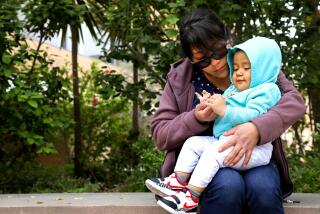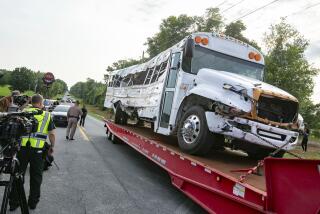Back From the Dead : Recovery: Juan Camacho is putting his life back together after fighting for his life on a freeway center median following a run-in with a hit-and-run driver 18 months ago.
- Share via
Around his tiny hometown in Oaxaca, Mexico, Juan Francisco Camacho is known as the man who came back from the dead.
To this day, the locals talk about how the 21-year-old country boy survived being smashed by a speeding hit-and-run driver 18 months ago while walking along a busy freeway north of the border.
They’re amazed at how he clung stubbornly to life for four days and nights while marooned on the freeway center median, nursing his shattered body while he shouted for help in Spanish, rattling tiny tree branches overhead in a wild attempt to alert one of the countless motorists who whizzed past without noticing him.
In May, 1990, the story of Camacho’s gritty roadside vigil and eventual rescue along Interstate 5 in Oceanside attracted worldwide attention, prompting hundreds of letters and get-well cards stuffed with cash and job offers from concerned people as far away as Alaska, Japan and Australia.
But until he showed up in his south-central Mexican village months after the accident, locals there didn’t get the whole story.
“They told me they thought I was dead,” the wiry, black-haired Camacho recalled, “that I couldn’t have lived through such a thing.”
But Juan Camacho survived.
Now, back in San Diego after more than a year of recuperating in Mexico, he has found that his struggles as an undocumented laborer, still reeling from the aftermath of his near-fatal injuries, have in some ways been as trying as those untold hours he languished along the freeway.
Almost two years after his accident, he still can’t run because of the lingering pain in his joints and thinks twice before crossing even a one-lane street, much less the wide expanse of a freeway. And as the calls and written expressions of concern have faded away, Camacho still finds himself hopelessly unemployed.
Living in a small house in Linda Vista with 14 other relatives, Camacho says the wincing pain he still feels from his shattered pelvis, broken knee and shoulder keeps him from returning to the burdensome day-labor routine in the growing fields in northern San Diego County.
Moreover, his health and legal status have cost him one restaurant and car wash job after another, forcing him to wonder how he will care for his young girlfriend and 3-week-old daughter.
Recently, he and his family have been forced to rely on the meager salary his mother earns as a domestic maid.
“Life is hard,” he said recently during an interview at a restaurant near where his accident occurred. “I am glad that I’m still alive, that I survived those days, but it’s hard to be happy when you can’t find work and constantly have to worry where the money is going to come from.”
As he talks, Camacho’s 18-year-old girlfriend, Aurora Olea, clutches the couple’s infant daughter, Magali, and softly strokes her man’s arm. Angry at the news of her pregnancy, the girl’s parents forced Camacho to bring Aurora and her unborn child along with him on his return to the United States.
After paying a documented woman from his village to smuggle her across the border, Camacho is feeling some very adult pressures to become a good provider, a competent father and, maybe someday soon, a devoted husband.
Unleashing a shy smile, the young man with a tattooed heart on his biceps--one without a name in the center--says he is not yet ready to settle down. Just then, the baby starts to cry. The smile drains quickly from his face.
His current domestic life seems so distant now from Camacho’s more spontaneous existence in a makeshift encampment in rural Bonsall. After first crossing north over the border in 1986, he regularly walked 20 miles a day in search of work in the area’s vegetable fields and packing plants.
On May 5, 1990--a Mexican holiday known as Cinco de Mayo--Camacho walked straight into a freeway mishap that transformed a frustrating day in search of work into the most trying time of his life.
In Mexico, he says, locals commonly use congested highways as pedestrian thoroughfares, so it was not unusual for him to pace along on-ramps and road shoulders in search of breaks in the traffic.
Camacho recalled that it was just turning dark when he left the last would-be job site in Oceanside and walked south along the freeway lanes just south of the Harbor Drive exit, looking for a chance to cross one of the busiest freeways in the United States.
Just then, he was hit from behind by a motorist who sped off into the darkness to the sound of “American music” blasting from the vehicle’s radio. The impact propelled Camacho into the middle of the freeway.
What happened over the next 96 hours has been relived time and again in Juan Camacho’s mind. While some of the details now escape him, he says, others return to him in his sleep or when he holds his infant daughter. They will not leave him alone.
He recalls that moment after he landed from the vehicle’s impact, when he rolled instinctively across the remaining two lanes to the safety of the median strip. The next hours passed in a blur from the shock that began to set in from his shattered pelvis, broken limbs and internal injuries.
At first, Camacho didn’t think he was hurt badly. Quickly, though, there was born a thought that soon rang clearly through a mind bleary from pain: He was going to die.
In the long hours to come, Camacho called out repeatedly for help, his cries drowned out by the hiss of the never-ending traffic. “The cars,” he said, “kept passing and passing and passing.”
On that first morning, he didn’t remember where he was.
Then he saw a man walking nearby and called out, begging him in Spanish to stop. The passer-by paused and looked around, Camacho recalls now, but couldn’t seem to make out where the voice was coming from.
Dressed in only a short-sleeved shirt, pants and thin jacket, he shivered at night and sweated through the day as his feverish temperature continued to soar. He sipped from the stub of a six-inch water sprinkler nozzle, a survival trick he had picked up in the workers’ camps.
By the third day, doctors say, Camacho inched closer to death. He passed out repeatedly and began vomiting blood.
Still, he continued to rattle the branches of the thick oleander bushes above his head in hopes of signaling a passing driver. He called out to the windows of the houses he could see just east of the freeway.
Delirious, he soon thought he heard responses coming from the two-foot-high steel barrier cables that run along the freeway median. They are voices, he says, that still call out to him.
On the fourth day, Juan Camacho’s luck began to change. A worker in a car-rental office adjacent to the freeway looked out her window and spotted a man slumped like a rag doll along the freeway median.
“He was just lying there, trying to get up,” Julie Carpenter recalled. “He would get up and then fall back down again, dragging himself along the ground.”
She mentioned the sighting to a nearby team of firefighters. Still, no search was ever made for Camacho. In the following weeks, the Oceanside Fire Department conducted an inquiry into its response to the sighting.
“We asked ourselves: ‘Did we screw up?’ but it was such a vague thing,” Deputy Fire Chief Jack Francis said. “This woman said she saw someone, but nobody else she talked to could see what she was talking about. It was like some ghost on the freeway.”
Ninety-six hours after he was struck, Juan Camacho was finally rescued. After crawling back out onto the road shoulder to become more visible, he was spotted by a passing motorist, who telephoned authorities.
As he recuperated at Scripps Memorial Hospital in La Jolla, Camacho was flooded with cards and letters written both in Spanish and English, offering jobs and more than $2,000 in cash and checks. He even got a note from former President Ronald Reagan.
Eventually, he tired of the limelight and sometimes covered his face when approached by a reporter or television camera. “To him, he did nothing that he considered heroic,” a friend said at the time.
“The life he had led in the migrant camps taught him how to be a survivor, how to find water, go without food. So surviving is nothing new to him.”
Dr. Edgar Gamboa, a trauma surgeon who treated Camacho, said he was amazed at the migrant worker’s stubborn battle to survive--as well as the resulting public response. He continues to receive an occasional letter for Camacho, and this Christmas received a card from a doctor in Madrid, Spain, praising his efforts to keep a penniless migrant worker alive.
Gamboa attributed Camacho’s survival to a trauma system operated by several San Diego-area hospitals that provides life-and-death care for all patients--including the indigent.
“People say that we’re wasting our money on this,” he said. “Like Juan Camacho, a lot of the people brought to hospitals have no money. But they’re human beings. They may be migrant workers and not your father or mother, but they deserve care.”
But even his doctor realizes the challenges that now face Camacho.
“He still feels the pain of the residual arthritis in his joints,” Gamboa said. “The joints never heal back to 100%. It’s like a football injury, and this man took quite a powerful hit.”
He owes his survival and recovery, Camacho says, to his patron St. Sebastian in whose honor he threw a party years ago to ask for protection before his first journey to the United States.
Looking back, Camacho doesn’t feel his guiding saint let him down by allowing him to be struck down on that freeway. Rather, his faith helped him stay alive.
And while his future looms as a frowning question mark, Juan Camacho says he has learned something from his dash across the freeway--and the resulting episode of horror.
Now he stops to enjoy the simple things in his life, like spending time with his mother or holding his doll-like infant daughter. And he’s become a more careful person, especially when crossing the street.
“When I cross,” he says, “I wait until there isn’t a car around for miles.”
More to Read
Sign up for Essential California
The most important California stories and recommendations in your inbox every morning.
You may occasionally receive promotional content from the Los Angeles Times.











